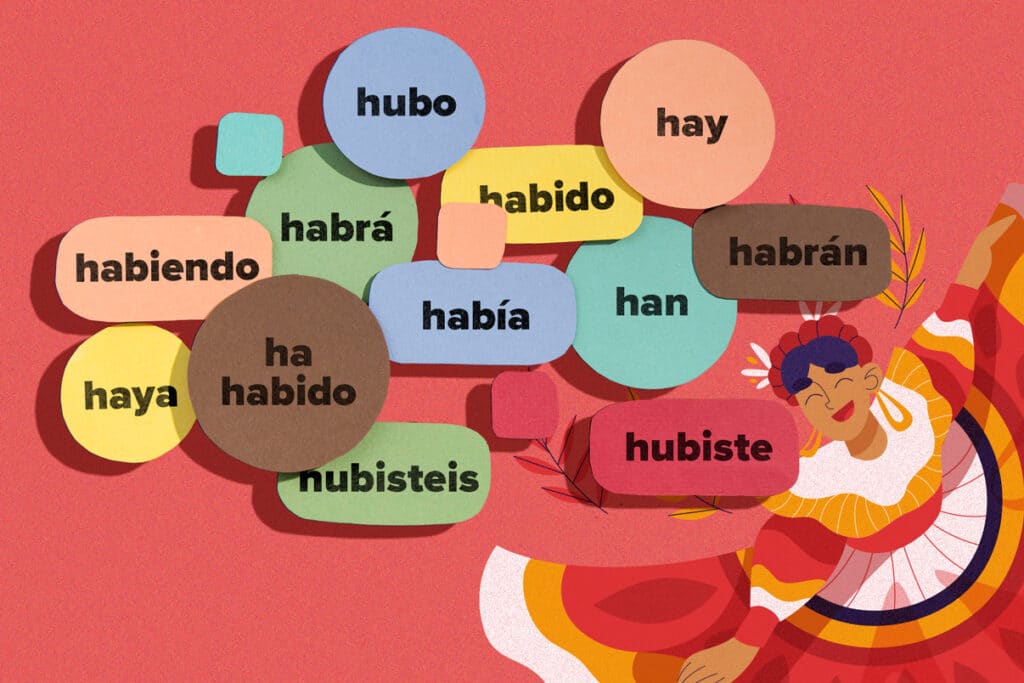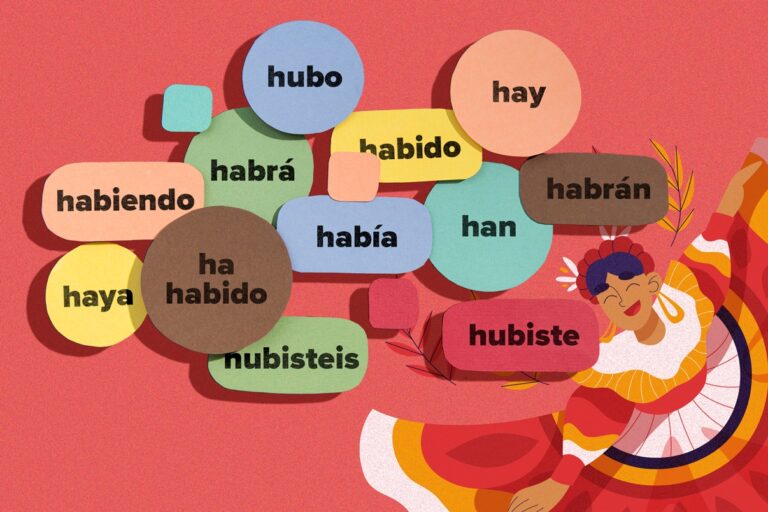
Haber is an auxiliary verb, which means it helps other verbs express their tense or mood.
You’ll hear it 24/7 in Spanish conversations, making it essential to learn.
Read on to learn how to use haber—including haber conjugations, meanings, usages and more—as an impersonal verb, an auxiliary verb and a participle.
We’ll also cover all of the haber conjugations and common expressions that use this verb.
Contents
Download:
This blog post is available as a convenient and portable PDF that you
can take anywhere.
Click here to get a copy. (Download)
Uses of Haber in Spanish
Haber can take the form of an impersonal verb, an auxiliary verb or a past participle, and can be used in the following ways:
- To indicate existence. The most basic use of haber is to indicate existence. This can be tangible, like Hay una mesa en el comedor (There is a table in the dining room). But it can also indicate something intangible, like Hay química entre nosotros (There is chemistry between us).
- To indicate a lack of existence. This is the opposite of the first usage. For example: No hay ninguna cama en la cocina (There isn’t any bed in the kitchen). You can also use it to ask if something exists: ¿Hay velas? (Are there any candles?).
- Shows what must be done when coupled with que. Haber que means “have to” or “must,” just like tener que. For example: Hay que tener cuidado (We/one/you/I must be careful).
- Acts as a helping verb supporting the sentence’s main verb. In this function, haber and its companion verb express an action that has been or will be completed. It’s roughly equivalent to the English “have” or “had.” For example: Había salido (I had left).
- Haber can be used as a present participle. You may see it in the present participle form (also known as the gerund), which never changes: habiendo. This translates to the English “having,” like this: Habiendo cenado, Luis decidió mirar televisión (Having eaten dinner, Luis decided to watch television).
- Haber can be used as a past participle. You may also see haber in the past participle form, paired with its auxiliary verb form: haber + habido. For example: Ha habido muchos cambios este año (There have been a lot of changes this year.)
Haber as an Impersonal Verb
Remember that as an impersonal verb (a verb that does not have a true subject), haber indicates existence and is always conjugated in the third-person form.
Let’s look at some more examples:
No habrá posibilidad de amor en mi vida, porque Ana no me quiere más.
(There will be no chance of love in my life, because Ana doesn’t love me anymore.)
Hay demasiada tristeza en las noticias.
(There is too much sadness on the news.)
Siempre hay gente que no cree en lo verdadero.
(There are always people who don’t believe in what is true.)
Impersonal Haber Conjugations in the Indicative
The indicative mood discusses facts—things that have happened, are happening or will happen.
Haber is conjugated in the indicative mood when it’s used as an impersonal verb. So it will take on one of these indicative tenses:
Impersonal Haber Conjugations in the Subjunctive
The subjunctive mood discusses opinions, perceptions, possibilities and more.
Here’s how to conjugate haber as an impersonal verb in the subjunctive mood:
Common Expressions with Hay
Many useful phrases in Spanish use hay.
You’ll hear these quite frequently, so I suggest adding them to your flashcard decks and committing them to memory:
- Hay de todo — There’s a bit of everything
- De lo que no hay — The worst/the pits
- Aquí hay tomate / Aquí hay gato encerrado — Something’s fishy (literally: here there are tomatoes)
- A buen hambre no hay pan duro — Beggars can’t be choosers (literally: to good hunger there isn’t hard bread)
- Es lo que hay — That’s all there is
- Hay de todo como en botica — There’s a wide range/there’s a bit of everything (literally: there’s everything like in the pharmacy)
- Hay más tiempo que vida — There’s all the time in the world (literally: there’s more time than life)
There are tons more expressions where you’ll encounter hay (or other forms of haber), but this list is enough to get you started.
Once you’ve committed these to memory though, I highly recommend searching for more the next time you chat with a native speaker or watch Spanish content.
Programs like FluentU make this even easier since interactive subtitles are added to every video.
These let you learn Spanish grammar and vocabulary in context, since you can hover over words and structures you don’t know to get instant definitions, pronunciations, examples and the option to add them to personalized flashcard decks.
You can also access the program as iOS and Android apps.
Haber as an Auxiliary Verb
When haber is used as an auxiliary verb, it is paired with another verb in the past participle form (ending with –ado or –ido) to talk about actions that have been or will be completed.
For example:
Han estudiado durante tres horas hoy.
(They have studied for three hours today.)
Mateo e Isabella habrán estado casados dos años este mes.
(Mateo and Isabella will have been married for two years this month.)
Auxiliary Haber Conjugations in the Indicative
In the indicative mood, you’ll see these forms of the auxiliary verb haber:
Haber as a Participle
You may also see haber in the past participle form, paired with its auxiliary verb form: haber + habido.
For example:
Ha habido muchos cambios este año.
(There have been a lot of changes this year.)
Participle Haber Conjugations in the Subjunctive
In the subjunctive mood, haber conjugates like this alongside the past participle form of another verb:
Just like the perfect tenses in the indicative mood, you’ll only ever use haber + habido in the third-person singular form.
Haber Practice Quiz
Now that you’ve learned all of the haber conjugations and uses, it’s time to put your new knowledge into practice.
Conjugate the correct form of haber to complete these sentences. The answer key is below!
1. ¿Cuántas manzanas ____ ? (How many apples are there?)
2. ____ dicho que no. (He had said no.)
3. Ya ____ terminado. (I have finished already.)
4. Espero que ____ muchos regalos. (I hope there are lots of gifts.)
5. ____ viajado para verte. (They have traveled to see you.)
6. ____ sido un buen día. (It has been a great day.)
7. ¿Por qué no ____ nadie aquí? (Why is there no one here?)
8. ____ tres helados. (There were three ice creams.)
9. ¡____ tanta nieve! (There’s so much snow!)
10. ____ caminado mucho. (We have walked a lot.)
Answer key:
1. Hay
2. Había
3. He
4. Haya
5. Han
6. Ha
7. Hay
8. Había
9. Hay
10. Hemos
So, what’s there in your dining room? Who is (or isn’t) there in your heart?
I think it’s your turn to practice haber conjugations now.
Download:
This blog post is available as a convenient and portable PDF that you
can take anywhere.
Click here to get a copy. (Download)



